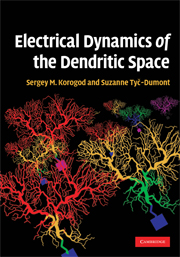Book contents
- Frontmatter
- Contents
- Preface
- 1 Definition of the neuron
- 2 3D geometry of dendritic arborizations
- 3 Basics in bioelectricity
- 4 Cable theory and dendrites
- 5 Voltage transfer over dendrites
- 6 Current transfer over dendrites
- 7 Electrical structure of an artificial dendritic path
- 8 Electrical structure of a bifurcation
- 9 Geography of the dendritic space
- 10 Electrical structures of biological dendrites
- 11 Electrical structure of the whole arborization
- 12 Electrical structures in 3D dendritic space
- 13 Dendritic space as a coder of the temporal output patterns
- 14 Concluding remarks
- Index
- References
6 - Current transfer over dendrites
Published online by Cambridge University Press: 03 May 2010
- Frontmatter
- Contents
- Preface
- 1 Definition of the neuron
- 2 3D geometry of dendritic arborizations
- 3 Basics in bioelectricity
- 4 Cable theory and dendrites
- 5 Voltage transfer over dendrites
- 6 Current transfer over dendrites
- 7 Electrical structure of an artificial dendritic path
- 8 Electrical structure of a bifurcation
- 9 Geography of the dendritic space
- 10 Electrical structures of biological dendrites
- 11 Electrical structure of the whole arborization
- 12 Electrical structures in 3D dendritic space
- 13 Dendritic space as a coder of the temporal output patterns
- 14 Concluding remarks
- Index
- References
Summary
Currents flowing between dendritic sites redistribute charges over the dendritic space. The spatial maps of the net current are complementary to the those of the membrane voltage. The current density maps show contributions, positive or negative, of different dendritic sites to the core current flowing in the dendrites. In neurons, the currents are transferred by ions, which are not only elementary charges but also elementary amounts of substance. The current flow into or out of a unitary volume of the dendritic space changes the amount of substance per unit volume, that is the concentration. Both electrical and chemical signalling in neurons is concentration dependent. The well-known examples include the Nernst equilibrium potentials for the transmembrane ion currents, the concentration-dependent currents such as calcium-dependent potassium current, concentration-dependent ion pumps in the plasma membrane and in the membrane of intracellular organelles, and finally ion concentration-dependent intracellular biochemical reactions of many vitally important substances. Hence, the current density maps are necessary for understanding the contribution of the current flow and substance fluxes across the membrane to the dynamics of ion concentration over the dendritic space.
Charge transfer ratio
The charge transfer ratio also called the relative effectiveness of the charge transfer, was first introduced by Barrett and Crill (1974) to characterize the contributions from different individual dendritic sites to the total somatopetal current transferred to the soma.
- Type
- Chapter
- Information
- Electrical Dynamics of the Dendritic Space , pp. 65 - 76Publisher: Cambridge University PressPrint publication year: 2009



